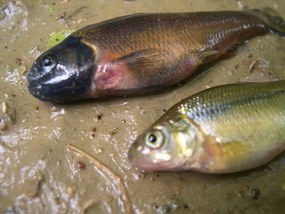
NPS Photo
At least eighteen different species of fish are known to occur within the six-plus miles of perennial stream found within Vicksburg National Military Park. All of these species save one are native to the lower Mississippi River drainage system. The one species that was introduced from outside the local ecosystem is Pimephales promelas, or the fathead minnow. This fish's native range extends from the upper Mississippi River north to Canada, and from Utah to Maine. But it is considered a good minnow for use as bait by fishermen to catch larger fish, which has resulted in the fathead minnow becoming established far beyond its native habitat. In fact, it can now be found in waters throughout the United States. The fathead minnow has a short, blunt snout (especially the males), and this accounts for its common name. (Its scientific name is descriptive as well. Its genus "Pimephales" is Latin for "fat head".) The males are more distinctively colored than the females, as is often the case in nature. They are greenish-brown on the upper body and silvery-white below, with a dark midlateral stripe. (The males also boast lighter vertical bands right behind the head and at mid-body.) Adult fish range in length from forty to 100 millimeters, with the male tending to be larger. Another example of the sexual dimorphism of this species is that the males develop tubercles, or small horny protrusions, on their snouts when they are in breeding condition. Open water is generally avoided by these minnows, as they prefer the cover of aquatic plants and rocks. These fish eat insects, algae, and other microscopic forms of life. At this they are very good, especially once they've been taken out of their native habitat and no longer have to compete with, or become prey to, other species that they co-evolved with. In streams such as those found at Vicksburg, the fathead minnow is at an advantage since it isn't kept in check by the other species. In fact, in some stream reaches within the park, it is thought that the fathead minnows may have displaced the native fish fauna. Park Service personnel and academic researchers are investigating this possibility. Another probable reason for the success of the fathead minnow is its high fecundity (or breeding rate) and the amount of parental care shown to its egg masses. Spawning occurs from May through August in calm stream shallows. The males select, prepare, and defend the nest sites which tend to be located on the undersurface of submerged stones or branches. A female can spawn every two to sixteen days and produce up to 10,000 eggs in a three-month season. The males stay by the egg masses and protect them from predation. They also fan the eggs with their fins to increase oxygen flow over the mass. There is even evidence that the males produce an anti-fungal property that they apply to the eggs through a pore on their neck! The eggs then hatch within four to ten days, depending on temperature. With characteristics such as these, it's easy to see why the fathead minnow has done so well outside of its original home range! |
Last updated: April 14, 2015
